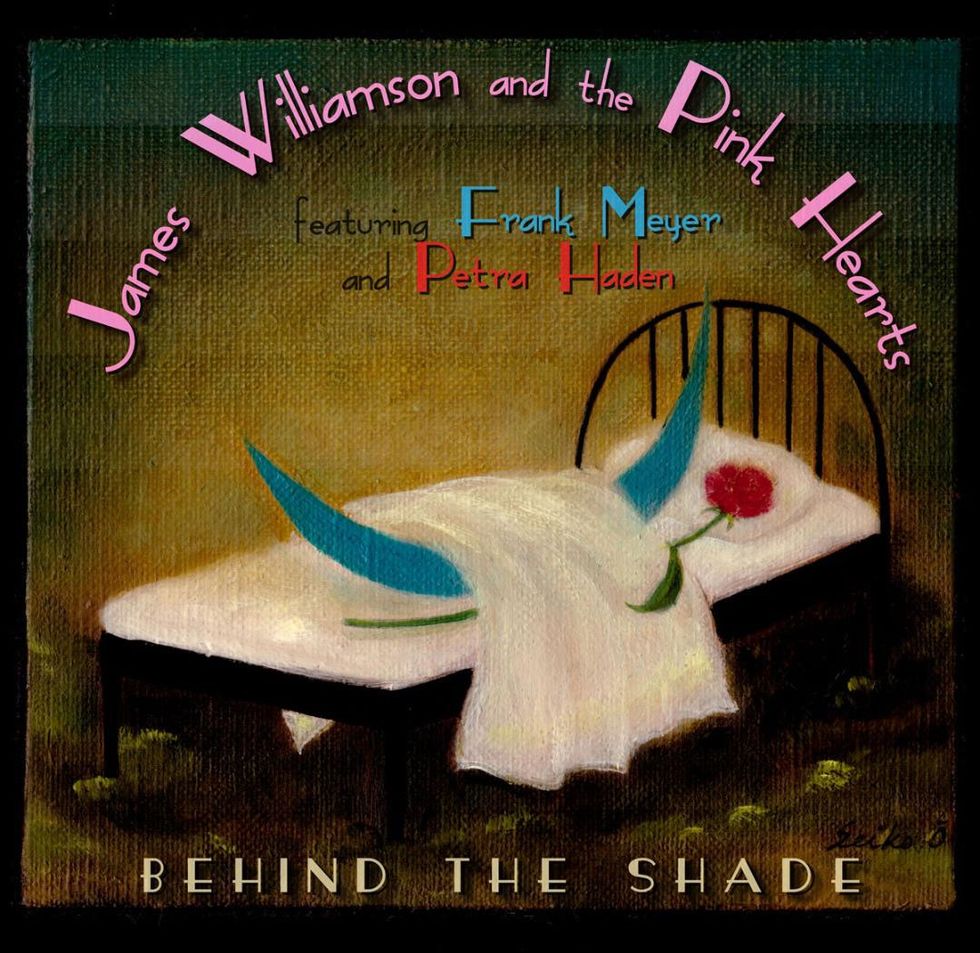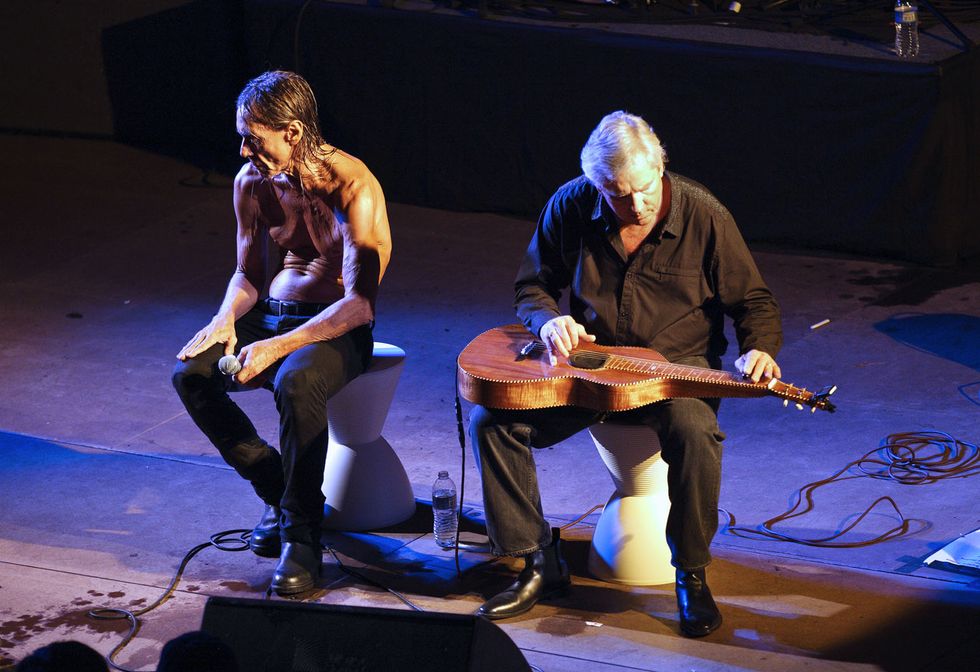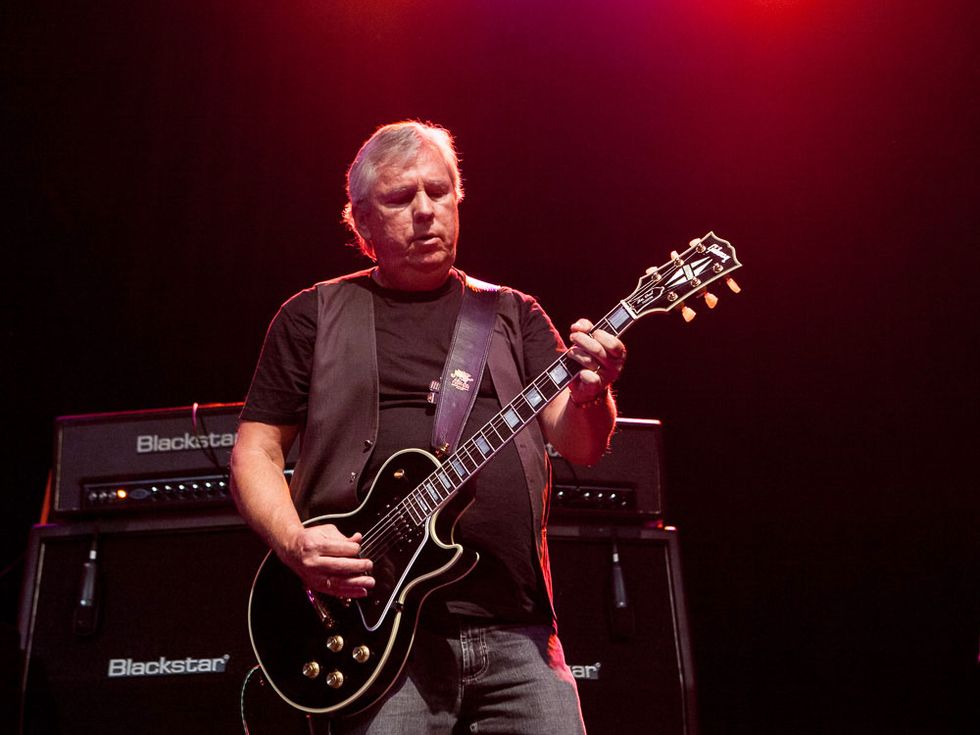James Williamson’s simple, violent rhythm work, searing leads, and iconic raunchy distortion on “Search and Destroy”—and all of the Stooges’ Raw Power—helped light the fuse and inform the sound of the punk rock revolution as it was ripe to explode. Williamson’s guitar work on Raw Power is imprinted within punk rock’s very DNA, from the records coming out of New York City in the early ’70s to the British class of ’77.
James R. Williamson was tasked with guitar and co-songwriting duties in the Stooges after the band’s original guitarist, Ron Asheton, was relegated from guitar to bass amid the incredible turbulence that characterized the Stooges’ world in the early ’70s. From the visceral guitar assault of tracks like “Search and Destroy” to the moody riffs of “Gimme Danger” to the psychedelic meanderings of “I Need Somebody,” Williamson’s 6-string is the true bedrock of Raw Power, and there is no doubt that his contributions to that highly influential album will continue to echo through the lexicon of guitar music for decades to come.
Williamson’s post-Stooges tale is nearly as compelling as that of the band’s own debauched early-’70s trip. The Stooges disbanded for the second and final time of their initial run in 1974—destitute, drug-addled, and in a state of obscurity following a failed attempt by David Bowie to help them break out in England.
In a stranger-than-fiction twist, the former guitarist of one of the most untamable bands of all time returned to the States to study electrical engineering and eventually re-emerged as a fixture in Silicon Valley, where he designed products around microchips when that technology was in its infancy. Williamson’s years in the tech world would prove to be tremendously fruitful and led to an executive role at Sony as the vice president of technological standards. He was heavily involved in developing Blu-ray data storage.
However, it’s no secret that the music-performance bug is an affliction few ever truly kill. Sony offered Williamson an early retirement package in 2009, the same year that Ron Asheton—who’d returned to the resuscitated Stooges’ guitar chair—died. Iggy Pop recognized an opportunity to finally celebrate the posthumous canonization of the Williamson-era Stooges and invited the guitarist back into the band for a whirlwind second life of touring. The group performed to massive generation-spanning audiences at major festivals, and even released a new album, 2013’s Ready to Die.
Williamson and Pop have since parted ways again, but Williamson’s second coming as a Stooge gave birth to a solo career and, now, a new band called James Williamson and the Pink Hearts, which features singer, frontman, and co-writer Frank Meyer (of the Streetwalkin’ Cheetahs), as well as singer Petra Haden. Their debut is the excellent Behind the Shade, which has its share of the high-octane rock ’n’ roll Williamson is best known for, but also shines a light on the facets of his songcraft that exist beyond the bombast of proto-punk. Juxtaposed against the album’s rock ragers like “Riot on the Strip” are alt-country ballads (“Pink Hearts Across the Sky”) and blue-eyed soul stompers (“You Send Me Down”). Above all, it shows a graceful evolution for the guitarist that nods plenty to the piss and vinegar of his past, but does not attempt to repeat it.
what people like about it.”
When PG spoke with Williamson, we delved deep into the often-overlooked ex-Stooge’s guitar world, discussed the recording of his killer new album and the gear he used to cop his inimitable guitar sound back in the day, and why he’s still an analog man during the digital revolution, despite his experience in the tech industry.
Your career as a guitarist—especially with the Stooges—is littered with unique, song-defining riffs. Do you think in terms of riffs, or do you look to the bigger picture of the song?
You know, it’s kind of the same thing to me. I think riffs are probably more an artifact of the way I go about writing a song, because a riff really is what comes up first. If I can’t come up with something that I consider interesting, which is almost always a riff, then I don’t pursue the song further. As a song progresses and develops—usually once I’m working with a singer—I start thinking in terms of structure and filling it out, but it mostly comes from riffs.
I’ve always felt like the same kid I was when I was sitting in my room trying to work stuff out on a guitar and using it solely as an emotional outlet, and I think that’s probably what people like about it. I was self-taught, for the most part—aside from an early lesson or two—and I pretty much just made stuff up from the very beginning. Part of it was that learning some of the guitar stuff I liked when I started was too difficult for me, so I just started making stuff up and I got better and better at it, and pretty soon I was in a band and had a place to play my stuff. People seemed to like it, so that was that.
I know you’re a blues fan and particularly big on Mike Bloomfield. Could you explain where the blues and Bloomfield come into your world as a guitarist?
When I was growing up, the British Invasion really overwhelmed everything else for us kids. I was maybe 15 at the time and all the girls were screaming about those bands. Therefore we were all interested in it.

TIDBIT: Although Williamson usually cuts tracks with the same rig he plays live, a Les Paul run through a Vox AC30, he also played a Telecaster and used an old Silvertone 1484 amp on Behind the Shade.
The blues came along a little bit later for us and the people that originally made it were finally being acknowledged as being the real innovators. The guys we looked up to, like the Stones, started acknowledging the blues guys that they’d been ripping off, so the original blues players became the real guys for us, rather than the English dudes playing their music and popularizing it. It was a period of discovery for a bunch of us, and certainly Paul Butterfield was the most accessible initially for us white kids for obvious cultural reasons at the time. I hadn’t discovered the deep guys like Howlin’ Wolf or anyone like that yet, but Bloomfield with Butterfield really brought the blues to white kids. Of course, Bloomfield’s style of playing was really so original, so he was someone important to me. I had to learn “Born in Chicago” and all of those songs, and I forget about him sometimes, but he was an amazing player and certainly very innovative.
Really, that same story fits the Stooges in a lot of ways. The posthumous popularity that we achieved is not far from what happened to the original blues players. We were never popular back in the day, and we actually broke up the final initial time because we just couldn’t make a living doing it. So the popularity that we eventually achieved came because the kids were listening to bands we had influenced, and then realized that they weren’t necessarily the real guys and that we were. When we reunited, the audience was full of twentysomethings, and I think it was exactly the same effect.
For every punk band that was influenced by “Search and Destroy,” there’s a player who was inspired by the way you play nuanced rhythm parts with melodies hidden in them, like in “Gimme Danger.” Guys like Johnny Marr, for example.
Yeah, and I must say that Johnny’s a really nice guy, by the way. The thing that I’m happy to hear is that you get that side of my playing. The thing that I think this album really displays is that side of my playing. For every “Raw Power” or “Search and Destroy,” there was a “Gimme Danger” or “I Need Somebody,” and I really focused on putting more of those types of songs into this album than I ever did back then. When you have a singer like Iggy Pop, who is so aggressive—though he can obviously croon—you have to do more uptempo things because they work really well with his thing. With Frank [Meyer] and Petra [Haden], you can give them just about anything for a guitar part and they’ll make a silk purse out of it because of how good they are with melodies.
Williamson helps Iggy Pop get in touch with his sensitive side, accompanying the legendary frontman on Weissenborn lap slide guitar—an instrument more typically associated today with the likes of Ben Harper and David Lindley.
Photo by Ken Settle
What gear did you use to track Behind the Shade?
Williamson: I pretty much used my regular stage rig for most things, which consists of a Les Paul—or a variation of a Les Paul—with a Vox AC30. The Vox I have now is a 1965 twin, so it’s a head and a cab. I’ve used that basic rig since Raw Power because of how great it sounds. There’s something special about humbuckers hitting an AC30 and I don’t think you can beat that sound, personally.
I did mix it up a little bit to suit some of the tracks. On one track, I used a Tele through an old Silvertone 2x12 combo. I believe it’s the 1484. I actually have my original one, which was my first amp that I had to talk my mom into getting for me because my uncle worked for Sears and I could use his discount. I played that amp in my first band, the Chosen Few, and when that band came to an end, the rhythm guitarist had a pair of boots I really liked, so I traded him the amp for those boots. He definitely got the better end of that deal, but later in life, he became an attorney in D.C. and he got in touch with me like a year ago and said, “I still have that amp in my basement. Do you want me to send it back?” and the rest is history. Those cabs are particle board, so it had totally deteriorated, but I replaced the cab and it sounds great. So some advice to everyone: Don’t throw those things away! I really don’t think I’ve ever played a Tele on a record before this, either. I do use one live for songs in open tunings.
Beyond that, I used a Martin D-28 and I have a really cool 1949 Martin D-18 that I just love the sound of. The wood is everything, and on those guitars, I just think the older the better. They don’t really come into their own into they’re almost sawdust, you know?
Your original ’73 Stooges Les Paul lives at the Rock & Roll Hall of Fame, so what Les Pauls are you using these days?
The original one in the Rock Hall was my only real vintage guitar, and I never thought anything sounded better than it. So I kept recording with it, but I wouldn’t take it on the road because I didn’t want to lose it or mess it up. I had a bunch of touring Les Paul Customs that I used that were all just reissues, and I’d go through a bunch of them to find ones I liked. I actually sent my Leopard Lady guitar [the Stooges Les Paul] to Jason Lollar and he took out the pickups and reverse engineered them so he could wind some new ones with the impedance characteristics of that guitar’s pickups. Because all of Gibson’s pickups were handwound back in the day, they all varied a bit, and these were actually pretty low impedance for humbuckers. I think the sound I’m known for comes from a low-impedance pickup into a loud amp, where the bite really comes from the amp itself. People like high-output pickups because they have some attack going on, but the high impedance actually makes them hard to control. With these, you can really crank the amp and get the sound I like without it being too unruly. So Lollar makes them now and sells them, and they’re called the Raw Power pickup.
Anyway, I had put those pickups in a lot of those touring guitars, but then I downsized a bunch of those touring guitars and, at the same time, Eastman Guitars came along and they sent me one of their guitars—an SB59/v—to try, and I was just blown away by the build quality. So I started playing those and I tricked mine for live shows with my Lollar pickups, and I also use the Fishman piezo bridge and I send that through stereo outputs, so I have a signal coming from both the magnetic pickups and the piezo, and I can switch between them on the guitar. I split that signal and send the piezo pickup to a Fishman Aura acoustic simulator, which gives me a very convincing acoustic sound with none of the feedback problems, and obviously the magnetic pickups go to my tube amp, and I can blend or switch between the two sounds, depending on the song.

Guitars
Eastman SB59/v with Lollar Raw Power pickups
1969 Gibson Les Paul Custom
2000s Gibson Les Paul Custom reissues with Lollar Raw Power pickups
Fender Telecaster with Lollar Pickups
Fender Telecaster Thinline with Telenator Wide Range pickups
2000s Martin D-28
1949 Martin D-18
Amps
1965 Vox AC30
1960s Silvertone 1484
Effects
Vintage Pedal Workshop F.E.T. booster
Strings and Picks
D’Addario EXL110 electric (.010–.046)
D’Addario EJ17 acoustic (.013-.056)
It’s easy to assume the sound of your guitar during the Stooges involved fuzz pedals, so it’s very interesting to find it’s a low-output pickup through a Vox AC30.
A big part of it is how loud and trebly I have the Vox set, too. That said, I do use a pedal made by a guy named Steve Giles, who is the guy that designed all of the reissue vintage-style Vox-y stuff that JMI makes. Steve had a pedal business on the side called Vintage Pedal Workshop, and he took the circuit he used in the JMI AC30 Top Boost section and put it into a pedal he called the F.E.T., and it’s a really good one. I love that thing because it doesn’t distort and it doesn’t really work as an overdrive pedal, but it gives you just enough top boost to cut through when you need it for solos. I didn’t use anything back in the day, but I use that now because it just makes things simpler.
Was there something specific that attracted you to Les Paul Customs?
It’s just been a lot of serendipity. I used to play a lot of different guitars when I first started, and I went through a lot of different models to figure out what I liked. My first guitar was a Fender Jaguar, which I think is kind of funny because Johnny Marr wound up using those after all these years, but when I joined the Stooges, I was playing an SG. The SG was a great guitar, but it didn’t sound like the right guitar for that band to me. So I went down with Iggy to the local music store in Ann Arbor and ended up trading the SG, my Jaguar, and a little bit of money for a new Les Paul. I don’t know that I got the best end of that deal, but that’s how I got the Leopard Lady guitar, and it obviously served me well! I really liked that sound from there on out, and that was my only guitar for many, many years.
With one of the Gibson Les Paul Customs he typically favors, James Williamson takes the stage as a Stooge during the band’s last run of performances. Although his preferred amp is a Vox AC30, he’s flanked here by two stacks of Blackstars. Photo by Tim Bugbee/Tinnitus Photography
As someone who’s had a career as a major player in the tech industry and a career as a producer, I find it interesting that you still favor such simple, vintage-style gear—especially considering the renaissance we’re going through with digital signal processing. Do you have an opinion on all of the DSP-based guitar tech coming out these days?
I try to continue using the things that are already working and have a quality I like to them, and I try to use newer things in the places that stuff comes up short. For example, I came up in the era of tape, and tape was a bitch. You’re there with a razorblade all night long editing and it’s a mess, and it’s noisy, and it was no fun to work with … but it was all we had. I think it’s so wonderful to have digital editing. It’s a completely new world that I didn’t have access to back in the day, so I love digital editing. But ... there are things about tape that are wonderful, particularly the kind of compression tape gets that you really just can’t get in the digital medium. There’s stuff that comes close, but you can always hear it if you really know what tape sounds like. It doesn’t always matter, especially if you’re making music for people that listen to nothing but MP3s, but if you’re making music for yourself—which is what I do—or for people that really pay attention to it, you want to make it as good as possible. And I think tape and the sounds of the ’70s, in general, are hard to beat. So I use stuff like Neve 1073 preamps and EQs, and the sounds I grew up with.
This album’s guitars have a lot of very thick tones, but it doesn’t sound heavily layered. Do you have a specific approach to tracking those chunky rhythm guitars?
Williamson: Yeah! I’ve developed a blend of stuff that seems to work well for me, even though a lot of guys see my setup and go, “Wow, man! Who set this up, because it must be phase city?” That’s because I use multiple mics on my amp: One is a Sennheiser and the other is Unidyne’s early version of an SM57. I’ll blend them until I get the tone I’m looking for, which can be thick thanks to some of those mics, but I also try to keep a really crisp high on top of it. It’s usually just one guitar track that’s feeding several mics. Sometimes I’ll doubletrack a guitar part, and because it’s me, I can get it pretty spot on when I play it again. But a lot of it is mics.
Which tracks on this album are in open tunings and which tunings are you using?
“Pink Hearts Across the Sky” and “Destiny Now” are, surprisingly for me, open G, which is something I don’t normally use because everything you play sounds like Keith Richards. I normally prefer open C, because I used it back in the day and not many people used it, and I think it sounds great. “No Sense of Crime” [from 1977’s Kill City] and some other older songs of mine are in open C. Live, I use a Telecaster for those tracks, but on the record, it’s a Tele, a Les Paul, and a Martin acoustic.
The acoustic guitar has played a major role in your sound over the years—especially in getting the layered textures that really filled up some of the iconic Stooges tracks like “Gimme Danger.” I understand you wrote all of those tunes on an old Gibson B-25, which are extremely underrated guitars. Do you still have that guitar and could you describe it?
Yeah, that’s correct. It was a ’70s model in natural. It’s at the Rock Hall with the Leopard Lady Les Paul now. I got that guitar when I first went over to London, and this one was actually kind of crappy. It had that adjustable bridge. I don’t know why they put those on there, but I swapped it for a fixed bridge and it sounded a lot better. I wrote a lot of those songs with it. We lived in a Mews house, which had shared walls, and you can’t rock out in that situation, so I could work out the details of songs with that, and it also allows you to really hear the notes a lot better. You get the purity of the notes and you know fast if you have it or you don’t. I’ve very rarely written on an electric guitar since.
Do you have a preferred version of the Raw Power mixes between Bowie’s original and Iggy’s 1996 remix for the deluxe reissue?
Hands down, I much prefer Bowie’s mix—really just because it’s the original. With all of its flaws and even despite Bowie’s artsy stamp and all that, it’s still the one everybody knows. You can’t change that or its place in time. There are technical reasons why that mix happened that way. And Iggy’s thing was kind of just ham-handed: put up all the faders and make it loud! There was a lot of digital distortion in that mix and it just didn’t work for me, but what it did do was get the album reissued, because it was out-of-print when he did that, so there’s a silver lining.
James Williamson fulfills his iconic role in the Stooges, backing up Iggy Pop with his Leopard Lady Les Paul onstage during the band’s Rock & Roll Hall of Fame induction in 2010. And yes, that’s Mike Watt playing bass!













![Rig Rundown: Russian Circles’ Mike Sullivan [2025]](https://www.premierguitar.com/media-library/youtube.jpg?id=62303631&width=1245&height=700&quality=70&coordinates=0%2C0%2C0%2C0)












![Rig Rundown: AFI [2025]](https://www.premierguitar.com/media-library/youtube.jpg?id=62064741&width=1245&height=700&quality=70&coordinates=0%2C0%2C0%2C0)




















 Zach loves his Sovtek Mig 60 head, which he plays through a cab he built himself at a pipe-organ shop in Denver. Every glue joint is lined with thin leather for maximum air tightness, and it’s stocked with Celestion G12M Greenback speakers.
Zach loves his Sovtek Mig 60 head, which he plays through a cab he built himself at a pipe-organ shop in Denver. Every glue joint is lined with thin leather for maximum air tightness, and it’s stocked with Celestion G12M Greenback speakers.











